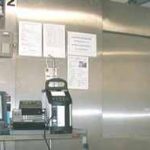Steam Sterilisation is the most common method used for insuring bacteria free equipment or product. A steam steriliser (often called an autoclave) can be one of the most challenging environmental chambers to thermally map and qualify.
Typically, an autoclave is qualified using a thermocouple based system (i.e. Lives XpertVal System). Thermocouples (16 or more) must first be calibrated using a temperature bath and reference probe. Next, the thermocouples must be carefully installed through the vacuum line using a special “feedthrough” flange (See Accessories). Pulling the thermocouples through the flange and mounting the tips in the autoclave can be quite time consuming. Also, vacuum leaks and broken thermocouples are common problems that can add to equipment downtime.
The only alternative to a thermocouple based system is using wireless dataloggers (i.e. Lives XpertLog System). Calibration and installation time using wireless dataloggers can save hours or even days compared to the thermocouple method.
The obvious question becomes:
“Why do I need to use thermocouples at all?”
The fact is that thermocouple based systems provide “live data” and wireless dataloggers do not. Seeing ‘live data” becomes advantageous for the initial qualification of new autoclave where mechanical adjustments may be required or load configurations need to be determined.
However, at least 95% of autoclave re-qualifications will pass testing and the ability to see “live data” is not necessary. For re-qualification work, the wireless dataloggers offers the greatest advantage to saving labour and production downtime (see chart).
Note: Formal re-qualifications of autoclaves are typically done each year and in some cases every three years. Another advantage to wireless dataloggers is the ability to perform periodic verifications of autoclave operations without disruption. This could be important to meeting cGMP standards for critical operations.


